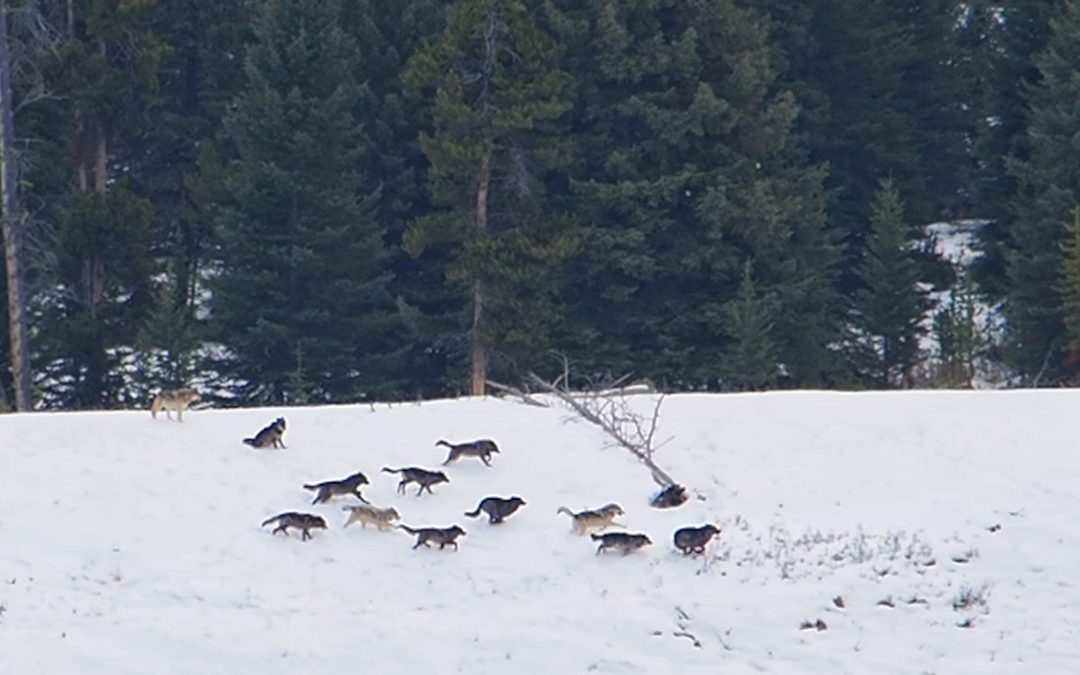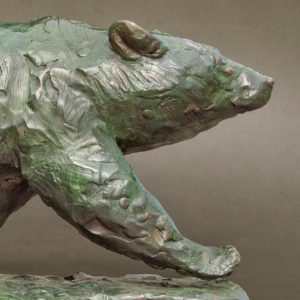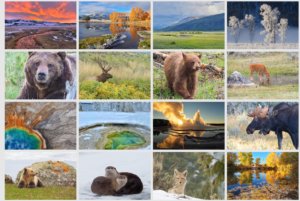Approximately one out of every five wolves in Yellowstone are parading along the valley before us as our son looks through the spotting scope. It’s the Junction Butte wolf pack.
“Whoa! I see them! They’re playing!” little George says with the uplift of awe in his voice. His friend Garrett, along for the weekend, exclaims too when his turn at the scope comes:
“Oh my gosh, look how many there are… they keep coming out of the trees!” Garrett begins counting to himself, out loud.
“One, two, three,… fifteen, sixteen, SEVENTEEN! I see SEVENTEEN!”
Before all is said and done, there are twenty-one Junction Butte wolves shape-shifting in and out of sight through the sprawling, snow-covered flats, scattered sagebrush, and forested obstacles of upright and horizontal trunks. Some wolves follow in the tracks of those before, and others chart their own parallel routes uphill or downhill from their kin. All of them are here, all twenty one wolves: the entire pack is moving in unison.
And move they do. Like red blood cells coursing through the vessels of this place, the wolves are a pulse, a capillary action that was pinched off for over seven decades before the reintroduction of wolves and the return of the flow. The mix of black and gray-coated wolves flow effortlessly through the white snow and black forest. Their work is focused, in the moment, and absolutely in tune with every sensory cue. The distance of half a mile is covered with ease, then a mile and then another is traversed with a grace only matched by the dip-and-rise flight of a single magpie overhead. The Russian proverb, “a wolf feeds itself with its feet,” slips through my mind.
The cursorial nature of the wolf is something to behold; each animal is poetry in motion. On bare ground, as in deep snow, the hind feet come down directly into the prints of the front and the individuals who follow register their own tracks precisely on top of those before them. Not unlike an indigenous war party of humans, the number of individuals is difficult to decipher from tracks alone. One might think they are following a single wolf through a snowy meadow only to find that it is two or perhaps three, once the tracks finally diverge. Wolves can travel this way for miles. Their trot of four to six miles per hour digests terrain with the same efficiency their stomachs do elk meat, easily covering fifteen or twenty miles without stopping. That seems to be case with what we see this morning: the Junctions travel from the far eastern side of Round Prairie at the beginning of this encounter, to the Lamar River–a distance of 5.5 miles– in about a hundred minutes.
There are a little over a hundred wolves in the Park’s population, and twenty one of them are part of one family; the Junction Butte pack. Not since the days of the Druid Peak pack, and only a few other scattered occasions, have so many wolves in the same pack been so visible to the public.
This is a multigenerational family: the founding parents commingle with their siblings, eldest children, younger offspring and finally, this year’s pups. Youngsters are the lifeblood of any pack; they are the future hunters, warriors, caregivers, scouts, sentinels. Without them the pack’s future is uncertain.
Identifying the puppies in the group at this time of year can be challenging. Despite being whelped in March or April, they are now almost indistinguishable from their parents, having grown to ninety percent of the dimensions and eighty percent the weight of an adult. Compare that to a grizzly bear cub, which can take up to three years before it’s large enough to be confused with it’s mother. However, the wolves’ raucous bounding, wrestling and pell-mell running into one another, along with crashing to the ground with tails flagging and playful mouths agape, gives the kids away. In addition to the endless playing, the neck and shoulder ruff of the traveling pack members can help sort the young from the old. Certainly the graying muzzles and flanks of the elder wolves stick out, but the wispy, overly long guard hairs projecting out of the wooly under fur betrays the youths in the group; not unlike the shock of blonde hair sprouting from the cowlick of my own son’s towhead as he gets ready for school, asking “how does my hair look?”
Serious things however, occupy adults while the kiddos play. Not to say that the adults don’t play, they do. Just like human parents, where rollicking with the kids is balanced against cleaning the fridge, packing lunches, or fixing frozen pipes in the dead of winter, so it is with the senior wolves of the Junctions. They walk directly from place to place, sniff with intention, placing their muzzles deep into the snow— prey? enemy? how long ago?—constantly aware and ever vigilant.
Although wolves are among the most studied creatures in the world today, they still hold great mysteries. The existence of so many wolves in this pack is a riddle in itself; in the spring these wolves were seen burying one of their own, a puppy, at their den site, and then possibly eating another. It was unthinkable that wolves would kill and eat their own—not only was this infanticide, it was cannibalism—of their own children! This did not jibe with anyone’s understanding of wolves, not the diehard wolf-watching community, nor Park biologists. It threw everyone for a loop, leading to more questions than answers. In spite of this, and after a mysterious disappearance into the backcountry following these events, the pack regrouped. Perhaps those pups were dying from an infectious disease or maybe the den had collapsed. Was this a necessary evil for the good of the pack, an unsavory series of deeds to protect the remaining young? These are questions only a wolf can answer.
Amazingly the Junction Butte Pack prevailed in rearing not only the remaining puppies from that ill-fated litter, but those of one or two others for a total of ten. Added to the eleven adults, the surviving pups of that dark time now fan out on the hills and valleys before us.
As the pack comes closer to the road in an attempt to pass through a bottleneck of surrounding mountains and hills (which is also where the road happens to go), I shush a man who is shouting to his wife back at the car. These opportunities are uncommon, even for those who live here, and the wolves hear everything; of this I am sure. Wolf biologist David Mech estimated that wolves can hear one another howl at distances of up to 10 miles away—fully four times the distance that most humans can detect their calls.
Through the spotting scope, I can see every rustle of their coats, the fluttering guard hairs in the breeze, their whiskers, their breath. With every footfall they glide across the snow tableau, and now, at a distance of only a few hundred yards, I can see the subtle rotation of their ears as they monitor their companions and the sounds from the road. They project an air of deceptive diffidence when uncomfortably close to Homo sapiens. Was this what George Catlin felt when when amidst the native American tribes of the upper Missouri? He was among the first Europeans to venture this way, an alien amidst a culture deeply tied to the land they called home. Through deeper and deeper study I do my best to dissolve the artificial otherness that still lingers between myself and these wolves. If there is anything I have learned from their kind, it is that we share far more than we do not.
Many cultures that still have threads of their ancestral ways will tell you of a time long ago when all species spoke the same language. We could freely communicate with all of life in the same tongue or perhaps it was without tongues altogether; maybe a look was—and still is—enough to put ourselves in that conversive space. I come away from mornings like this with a building feeling in my chest of emotion, energy and a taste of something timeless. Yet, in the end, I still come away feeling as though something mystical is still just out of reach. I wind up with more questions than I have answers: the mystery and intrigue only increases.
Suddenly, one of the Junction Butte wolves looks directly at us.
“He is looking at me,” I have heard others say in the past as a wolf pauses from its wolfness to gaze their way. So it is when looking into the eyes of a wolf: all at once the motion stops, if only for one fleeting moment, and those green eyes, set against a black mask stops the people who are gazing back in their tracks. Such is the power of the window into the soul—it can arrest the pulse of another across amazing voids of space. There is a message there; a cliff note that tips you off that the book might be about to open, an invitation to read a little more…But then the cover shuts as the wolf turns away and resumes it’s activity. But we are left changed, mesmerized, and grateful beyond measure.
If you’d like to read more about our encounters with wolves in Yellowstone, have we got stories to share! See Capturing a Grizzly Bear and Wolf Interaction in Sculpture, The Making of a Wolf Sculpture, Telling the Stories of Yellowstone Wolves, Enduring Spirit: The Last Days of the Druid Peak Pack, How Wolves Get a Date in Yellowstone, and Using Animal Language to Find Wolves and Bears in Yellowstone.
Video and images © Jenny Golding/George Bumann/A Yellowstone Life




